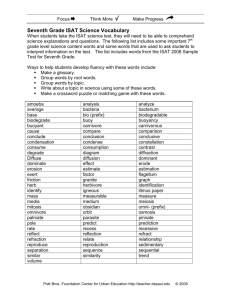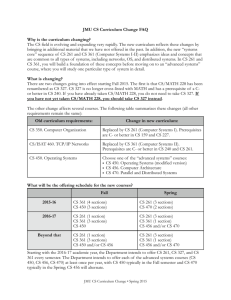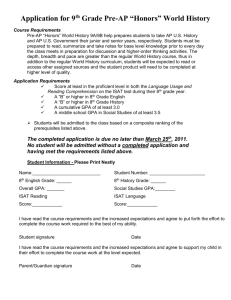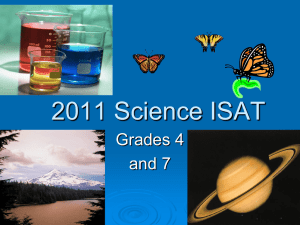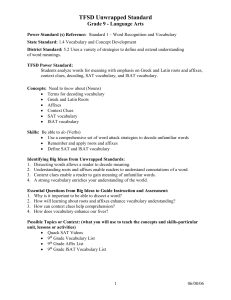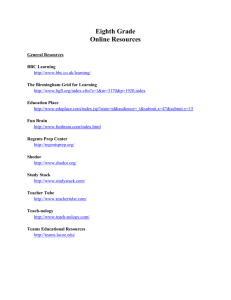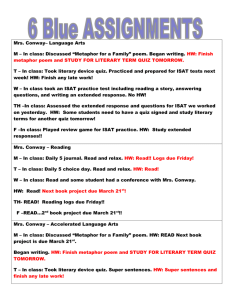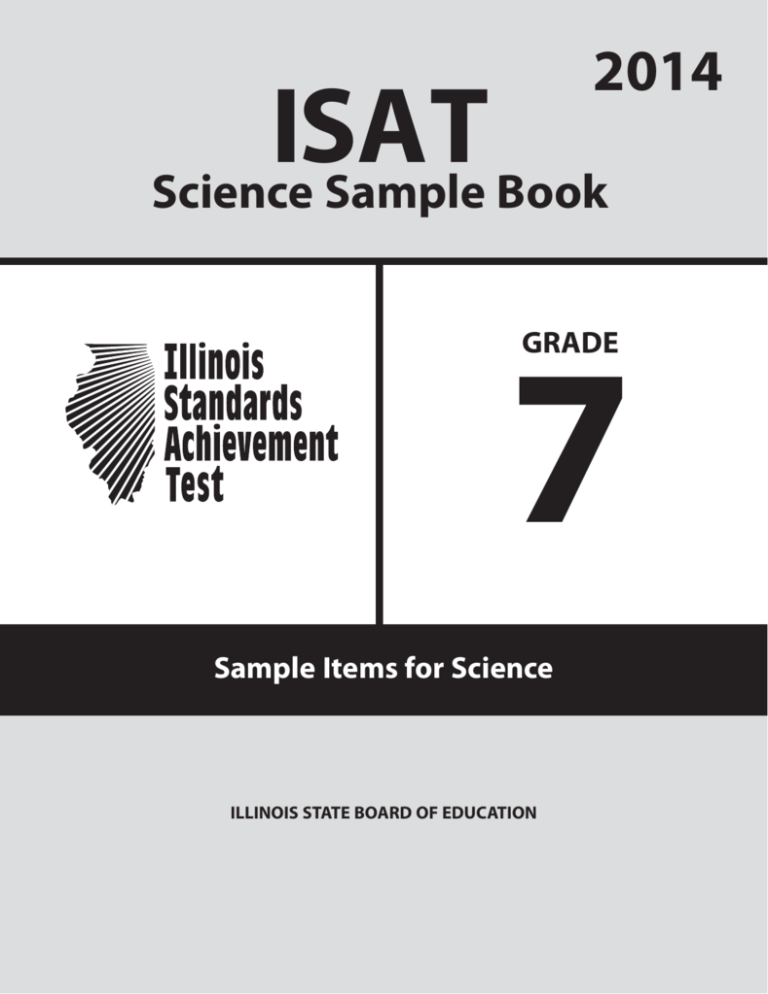
2014
ISAT
Science Sample Book
GRADE
7
Sample Items for Science
ILLINOIS STATE BOARD OF EDUCATION
Copyright © 2013 Illinois State Board of Education.
All rights reserved. This publication may be reproduced or transmitted by downloading and printing
for the purpose of practice testing and not for distribution or resale.
Portions of this work were previously published.
2014 ISAT Grade 7 Sample Book
Table of Contents
Introduction ............................................................................................................................5
SCIENCE
Structure of the Grade 7 Science ISAT ..................................................................................7
Item Formats....................................................................................................................................................7
Science Sessions ............................................................................................................................................7
Cumulative Knowledge ..............................................................................................................................7
Multiple-Choice Sample Items ..............................................................................................8
Answer Key with Assessment Objectives Identified ........................................................33
3
2014 ISAT Grade 7 Sample Book
4
2014 ISAT Grade 7 Sample Book
Introduction
This sample book contains sample ISAT science items classified with an assessment objective from
the Illinois Assessment Frameworks. These 2014 samples are meant to give educators and students a
general sense of how items are formatted for ISAT. All 2014 ISAT test booklets will be printed in
color. This sample book does not cover the entire content of what may be assessed. Please refer to
the Illinois Assessment Frameworks for complete descriptions of the content to be assessed at each
grade level and subject area. The Illinois Assessment Frameworks are available online at
www.isbe.net/assessment/IAFindex.htm. The Student Assessment Web site contains additional
information about state testing (www.isbe.net/assessment).
5
Illinois Standards Achievement Test
Science Samples
6
2014 ISAT Grade 7 Sample Book
Structure of the Grade 7 Science ISAT
ISAT Science testing in spring 2014 will consist of 82 criterion-referenced items written by Illinois
educators.
Item Formats
All 82 items will be in multiple-choice format. All items are aligned to the Illinois Science Assessment
Framework, which defines the elements of the Illinois Learning Standards that are suitable for state
testing.
Science Sessions
All standard time administration test sessions are a minimum of 45 minutes in length. Any student
who is still actively engaged in testing when the 45 minutes have elapsed will be allowed up to an
additional 10 minutes to complete that test session. More details about how to administer this extra
time will appear in the ISAT Test Administration Manual. This policy does not affect students who
already receive extended time as determined by their IEP.
Science ISAT Grade 7
Session 1
45 minutes
41 multiple-choice items
Session 2
45 minutes
41 multiple-choice items
(Some items will be pilot items.)
Cumulative Knowledge
ISAT tests students on the knowledge and skills that they should have acquired by grade 4 and
grade 7. Proper curriculum alignment can establish which assessment objectives are covered at each
grade level so that by the spring of any given year, all objectives have been presented. It is not the
sole responsibility of a 4th grade teacher or a 7th grade teacher to teach all of the assessment
objectives contained within the framework.
The grade 4 ISAT will assess the grade 4 assessment objectives. The grade 7 ISAT will assess the
grade 7 assessment objectives but may also include the assessment objectives from grade 4. The
sample items within this booklet provide the reader with an opportunity to see the ISAT format and
how the items align to the assessment framework.
7
Science
2014 ISAT Grade 7 Sample Book
1
2
Ramon sat two glasses of water
outside next to each other for 15
minutes. Each glass had the same
amount of water. One glass was
covered with black paper and one
was covered with white paper. He
took the following temperatures.
Temperature
Time
of Water
(Minutes) With Black
Paper (°C)
A manufacturer is conducting
research using a hammock they want
to sell to consumers. The
manufacturer places different
amounts of mass on the hammock
and observes what happens to the
hammock.
Temperature
of Water
With White
Paper (°C)
1
22
22
5
24
23
10
27
25
15
28
27
Which feature of the hammock
is the manufacturer most likely
testing?
What is the variable being
tested in this experiment?
A
B
C
D
A The force required to break the
ropes
B The force required to swing the
hammock
C The color and style preference of
consumers
D The damage to the hammock
caused by the sun
The color of paper
The size of glass
The amount of water
The location of the glass
8
GO ON
Science
2014 ISAT Grade 7 Sample Book
3
4
Tim rolled marbles down a ramp to
discover how far a cup would move
as more marbles were added.
Miguel wants his toy car to
reach the bottom of a ramp as
fast as possible. Which ramp
will result in the fastest speed?
Marble Motion
Number of
Marbles
Distance the
Cup Slides
1
2 cm
2
3 cm
3
4 cm
4
5 cm
A
B
C
D
A carpeted ramp
A wood ramp
A sandpaper ramp
A cork ramp
Which conclusion is best
supported by the data?
A Using more marbles made the
cup move farther.
B Using fewer marbles made the
cup move faster.
C Gravity moved the cup no
matter how many marbles were
used.
D Friction stopped the cup when
no marbles were used.
9
GO ON
Science
2014 ISAT Grade 7 Sample Book
5
SOLID WASTE IN THE UNITED STATES
Type of Waste
Millions
of Tons Percent
2,340
Crop
1,620
Mineral Industries
Industrial (NOT hazardous) 225
Household
180
Paper
72
Yard waste
32
Rubber, cloth, wood 21
Metals
15
14
Plastics
13
Food waste
13
Glass
90
Power Companies
45
Hazardous
3
Radioactive
52
36
5
4
2
1
0.0007
Crops produce the greatest
amount of waste, mainly from
plant parts not harvested as
food. Why are most people less
concerned about crop waste
than other types of waste?
A Farmers burn the waste instead
of sending it to landfills.
B Crop waste is returned to the
soil to decompose and enrich
the soil.
C Most crop waste is used to make
new products.
D Crop waste only accounts for a
small percent of all waste.
10
GO ON
Science
2014 ISAT Grade 7 Sample Book
3484805
6
3484805_AR1
An experiment was conducted to determine the feeding rate at which two different water
beetles eat frog eggs. The data are shown in the following graph.
Total Number of Frog Eggs Eaten
50
+
40
+
+
+
+
30
20
10
0
Beetle A =
Beetle B =
+
+
+
1
2
3
4
5
6
Time (minutes)
How many frog eggs did Beetle B eat in the first 4 minutes?
≥
A
B
C
D
20
30
60
90
11
GO ON
Science
2014 ISAT Grade 7 Sample Book
3484806
7
Compound,
Simple,
many leaflets
one leaf
[Honey Locust] [White Oak]
3484806_AR1
Compound,
Simple,
many leaflets
one leaf
[Horse Chestnut] [Silver Maple]
ALTERNATE
Long,
in bunches of 5
[White Pine]
on
stem
on
stem
OPPOSITE
Short,
in bunches of 3
[Yellow Pine]
BROAD AND FLAT
WITH NEEDLES
LEAVES OF TREES
What is the name of this plant?
≥A
White Pine
B Honey Locust
C Silver Maple
D White Oak
12
GO ON
Science
2014 ISAT Grade 7 Sample Book
3346316
8
3346316_AR1
3348364
9
A Euglena contains a structure called
a flagellum.
An amoeba divides into two
identical daughter cells. They
have exactly the same
characteristics as the parent
amoeba. Which best describes
the amoeba’s division?
Flagellum
≥
A
B
C
D
Diffusion
Meiosis
Mitosis
Osmosis
3484786
10
What is the function of the
flagellum?
≥
A
B
C
D
Reproduction
Movement
Protection
Food gathering
B
b
B
BB
Bb
b
Bb
bb
3484786_AR1
This is a diagram of a genetic
cross. In guinea pigs, black
hair color is dominant (B) and
white hair color is recessive (b).
What hair color are the guinea
pigs’ offspring?
≥
13
A
B
C
D
All black
All white
Mostly black with some white
Mostly white with some black
GO ON
Science
2014 ISAT Grade 7 Sample Book
3484788
11
3484804
13
In a food chain, which are
the most efficient users of
solar energy?
≥A
Herbivores
B Carnivores
C Omnivores
D Parasites
3484804_AR1
Group A
Group B
Grasshopper
Owl
Deer
Opossum
Robin
Moth
Beaver
Bat
Why were these animals placed
into these groups?
3461796
12
≥A
One group is active during
the day; the other group is
active at night.
B One group lives near
prairies; the other group
lives near forests.
C One group benefits people; the
other group is a pest to people.
D One group eats only plants; the
other group eats only meat.
In Illinois, the constellation
Orion can be seen in the night
sky in winter. Why can this
constellation not be seen in the
summer?
≥
A Earth is tilted away from the
constellation.
B Earth orbits to the other side of
the sun.
C Brighter constellations block
Orion from view in the
Northern Hemisphere.
D The orbit of the moon blocks
Orion from view in the
Northern Hemisphere.
3484787
14
Green plants are important to
animals because the plants —
≥
14
A consume food and give
off oxygen
B consume food and give
off carbon dioxide
C produce food and give
off oxygen
D produce food and give
off carbon dioxide
GO ON
Science
2014 ISAT Grade 7 Sample Book
3484789
15
3484801
17
3484801_AR1
Snakes feed on mice. The mice
eat grain crops. When the crops
are plentiful, what will happen?
≥
A The mouse population
will decrease.
B The snake population
will increase.
C The snake population
will decrease.
D The mouse population
will not change.
3484800
16
You need to put a metal rod
into a hole in a metal cylinder.
It is too tight. Which would
be the best strategy to make
the rod fit?
3484800_AR1
Snake
Hawk
Bird
Squirrel
≥
Level III
Fox
Rabbit
Mole
Insect
Level II
Plants
A Heat the rod and cylinder.
B Cool the rod and cylinder.
C Heat the rod and cool
the cylinder.
D Cool the rod and heat
the cylinder.
Level I
If foxes and hawks are
removed from this food web,
one result will be —
≥
A
B
C
D
a decrease in snakes
an increase in rabbits
an increase in insects
a decrease in moles
15
GO ON
Science
2014 ISAT Grade 7 Sample Book
3484797
18
3345497
20
Which is the best method for
a student to identify a solution
as an acid or a base?
What property of light waves
can be observed as light waves
pass from one medium to
another and change speed?
≥A
Use litmus paper.
B Taste the solution.
C Dilute in water.
D Heat the solution.
≥
A
B
C
D
Diffraction
Refraction
Reflection
Separation
3484790
19
Most of the chemical energy of
the gasoline burned in a car is
not used to move the car but is
changed into —
≥
A
B
C
D
XNG018
21
electricity
heat
magnetism
sound
XNG018.AR1
Applying the brakes on this
bicycle causes it to slow down
because the brakes —
≥A
produce friction
B use gravity to slow down the
bicycle
C add energy to the bicycle
D help cool the bicycle’s tires
16
GO ON
Science
2014 ISAT Grade 7 Sample Book
22
1
2
3
4
If these four identical balls are dropped at the same time and from the same height,
which ball will land first?
A
B
C
D
Ball 1
Ball 2
Ball 3
Ball 4
17
GO ON
Science
2014 ISAT Grade 7 Sample Book
YNF156
23
3348422
25
What type of rock is formed in
layers?
Which of these parts of an
animal would be most likely to
form a fossil?
≥
A
B
C
D
≥A
Sedimentary
B Igneous
C Granite
D Obsidian
Heart
Kidney
Eye
Tooth
3484793
24
1
3
Sediment
3
Lithification
Sedimentary
Rock
2
Metamorphism
Igneous
Rock
5
3484802_AR1
Rock Cycle
4
Weathering
4
2
3484802
26
3484793_AR1
6
Metamorphic
Rock
5
Cooling
(or crystallization)
Which rock layer is probably
the oldest?
≥
A
B
C
D
Magma
1
Melting
Erosion occurs at —
1
3
4
6
≥
18
A
B
C
D
position 1
position 2
position 3
position 4
GO ON
Science
2014 ISAT Grade 7 Sample Book
3344829
27
3484795
29
Wind occurs when air masses
move from one place to
another. What causes the
movement of air masses?
≥
A
B
C
D
3484795_AR1
Position 2
Position 4
The position of the moon
The heating of the air
The rotation of Earth
The condensation of air
Position 1
Sun
June
21st
Position 3
3461819
28
Earth Orbit
What does the color of a star
indicate?
≥
A
B
C
D
At which position in Earth’s
orbit are daytime and
nighttime equal?
Age
Size
Distance
Temperature
≥A
1
B 2
C 3
D 4
19
GO ON
Science
2014 ISAT Grade 7 Sample Book
3484798
30
3461824
31
When modern
disease-controlling
medicines and practices
are introduced in developing
countries, the first major
change is that —
Karen just bought a new battery
for her car. What should she do
with the old battery?
≥A
life spans increase
B birthrates decrease
C the population decreases
D the water supply increases
≥
20
A Wrap the battery in a
biodegradable bag and bury it.
B Put it in the garbage to be taken
to a landfill.
C Dispose of it in the empty field
behind her house.
D Leave it with the dealer to
recycle.
GO ON
Science
2014 ISAT Grade 7 Sample Book
3547798
32
3547798_AR1 to AR4
Which pole arrangement of the four magnets will hold the cabinet door shut most
tightly when it is closed?
S
N
N
S
N
S
S
N
N
S
≥
A
N
S
S
N
C
N
S
N
S
S
N
N
S
N
S
S
N
S
N
S
N
B
S
N
D
21
GO ON
Science
2014 ISAT Grade 7 Sample Book
3461806
33
3461823
35
New studies on a drug that
regulates blood pressure show
that it can cause harmful
side effects if used for many
years. What should the
manufacturer do?
Why are different constellations
of stars seen during different
seasons?
≥A
Earth is on a different side of the
sun during each season.
B Seasonal changes in the
magnetic poles create the
northern lights, which block
the view.
C The Milky Way revolves to a
different position with each
season.
D Constellations move around the
sun during different seasons.
≥A
Inform the public and remove
the drug from the market
immediately.
B Ignore the new studies because
all drugs have harmful long-term
side effects.
C Market the drug under a new
name to avoid bad publicity.
D Destroy the new results.
3547904
34
DNA testing is important in —
≥
A
B
C
D
architecture.
law enforcement.
computer programming.
banking.
22
GO ON
Science
2014 ISAT Grade 7 Sample Book
3547907
36
3547907_AR1
G
F
H
Earth
Sunlight
E
A
D
B
C
As seen from Earth, at which position would the moon appear to be full?
≥A
Position A
B Position B
C Position C
D Position D
23
GO ON
Science
2014 ISAT Grade 7 Sample Book
3533604 3533604_AR1
37
3531254 3531254_AR1
38
A Soil Profile
1
2
3
4
Which best describes the
characteristics of this leaf?
≥
A
B
C
D
5
Simple, pinnate
Simple, palmate
Compound, pinnate
Compound, palmate
According to the soil profile,
in which layer are most of the
soil’s nutrients most likely
found?
≥A
1
B 2
C 3
D 5
24
GO ON
Science
2014 ISAT Grade 7 Sample Book
3461793
39
3469655
41
Percentage Home Use of Water (U.S.)
After a recent experiment, a
scientist noticed that the
computer simulation varied
from the actual experiment.
What should the scientist do?
Household Cleaning
3%
Laundry
Drinking
≥A
Repeat the experiment several
times in order to verify the
results.
B Adjust the computer’s program
so it matches the actual results.
C Ignore the actual results as
inaccurate because computers
are very precise.
D Ignore the simulation as
inaccurate because of a possible
computer virus.
Kitchen
Use
≥
Flush Toilets
40%
Bathing
37%
The percentages show how
water is used in homes in the
United States. Which is most
likely to conserve the most
water?
Which structure makes a plant
cell rigid?
A
B
C
D
Garden/Lawn
3%
Car Washing
1%
4%
5%
7%
3344862
40
3469655_AR1
≥A
Reducing the water used to
flush toilets
B Putting suds savers on
washing machines
C Prohibiting the use of treated
water for lawns and gardens
D Reducing the amount of water
used per load in a dishwasher
Chromosome
Chloroplast
Cell wall
Cell membrane
25
GO ON
Science
2014 ISAT Grade 7 Sample Book
3461799
42
3346357
44
A scientific illustrator was asked
to draw the human digestive
system. Knowledge of which
branch of science would help
her the most?
≥
A
B
C
D
3346357_AR1
A lab group is given 5 meters of
string, a drinking straw, a balloon,
and tape. The group uses these
materials to demonstrate rocket
motion as shown below.
Geology
Ecology
Anatomy
Paleontology
3461820
43
What would most likely make
the balloon rocket go faster?
Why does the moon have more
effect on the tides than the sun?
≥
A The moon is more dense than
the sun.
B The moon is in motion in space,
while the sun is not.
C The moon is larger than the sun.
D The moon is nearer to Earth
than the sun.
≥
26
A Holding the string so that it is
less tight
B Using a wider straw
C Filling the balloon with more air
D Wrapping the tape all the way
around the balloon
GO ON
Science
2014 ISAT Grade 7 Sample Book
45
47
Some scientists are concerned
that television, radio, and
newspapers report the outcome
of experiments too quickly.
What would be the major
scientific concern?
t = 0 seconds
ramp
100 cm
A Conclusions may be drawn by
the public before the results are
verified by other laboratories.
B Other agencies may hear of the
experiments and claim credit
for them.
C Commercial organizations may
copy the ideas and sell them
for profit.
D The level of scientific research is
lowered to a media event.
t = 2 seconds
In 2 seconds, a ball travels
100 cm. What is the average
speed of the ball?
A
B
C
D
25 cm/sec
50 cm/sec
100 cm/sec
200 cm/sec
48
work ⫽ force ⫻ distance
46
A girl weighs 200 newtons. How
much work does she do
climbing 10 meters of steps?
A politician supports a bill to
increase the drilling of offshore
oil wells. What is the most
likely reason that he supports
the bill?
A
B
C
D
A Hurricanes offshore could cause
oil pollution.
B Offshore wildlife will increase in
numbers.
C People would have more oil
to use.
D Beaches along the shore could
be polluted.
27
20 joules
190 joules
210 joules
2000 joules
GO ON
Science
2014 ISAT Grade 7 Sample Book
49
50
Mitosis
The picture below shows a section of
the periodic table of elements.
Meiosis
7
N
8
O
14.007
15.999
15
16
30.974
32.06
33
34
P
As
74.922
S
Se
78.96
9
F
18.998
17
Cl
35.453
35
Br
79.904
Which three elements should
be classified together?
A
B
C
D
Why does a gamete produced
during meiosis have half as
many chromosomes as a
daughter cell produced during
mitosis?
Nitrogen, fluorine, bromine
Astatine, sulfur, fluorine
Nitrogen, sulfur, bromine
Oxygen, sulfur, selenium
51
When heated, sulfuric acid
breaks down into sulfur trioxide
and water. From the equation
below, which answer shows the
equation as balanced?
A Meiosis does not involve a step
in which the original cell makes
a copy of its chromosomes.
B Meiosis involves a second cell
division that separates identical
chromosomes.
C Mitosis does not involve a step
in which the original cell makes
a copy of its chromosomes.
D Mitosis involves a second cell
division that separates identical
chromosomes.
H2SO4 → H2O ⫹ S___
A
B
C
D
28
O3
O2
O4
O5
GO ON
Science
2014 ISAT Grade 7 Sample Book
52
Ryan and Kim-Lee boiled some water in a beaker. Then they turned off the heat source
and added five ice cubes to the water. Which of these thermometers shows what most
likely happened to the temperature of the water after ten minutes?
CELSIUS
130º
120º
110º
100º
90º
80º
70º
60º
50º
40º
30º
20º
10º
0º
-10º
CELSIUS
130º
120º
110º
100º
90º
80º
70º
60º
50º
40º
30º
20º
10º
0º
-10º
CELSIUS
130º
120º
110º
100º
90º
80º
70º
60º
50º
40º
30º
20º
10º
0º
-10º
CELSIUS
130º
120º
110º
100º
90º
80º
70º
60º
50º
40º
30º
20º
10º
0º
-10º
A
B
C
D
53
54
Dave read that on January 1,
Earth is slightly closer to the
sun than on July 1. Why, then,
is it colder in Illinois in January
than in July?
Jenna flips a coin ten times. It
lands on heads seven times and
on tails three times. She
concludes that a coin lands on
heads more often than on tails.
Why is her conclusion possibly
invalid, even though it agrees
with her results?
A The Northern Hemisphere is
tilted away from the sun in
January.
B The greenhouse effect is stronger
in the Northern Hemisphere in
July.
C The snow on the ground lowers
the air temperature in January.
D The moon pulls the heat away
from Earth in January.
A Her results would probably differ
if she collected more data.
B Newton’s third law of motion
contradicts her conclusion.
C She should have flipped the coin
only twice.
D She did not state a hypothesis.
29
GO ON
Science
2014 ISAT Grade 7 Sample Book
55
56
Which label represents the
greatest potential hazard in the
lab setup shown?
1
2
2
1
4
3
3
4
A
B
C
D
In the diagram, which feature is
most useful in classifying this
leaf as a dicot?
A
B
C
D
1
2
3
4
1
2
3
4
30
GO ON
Science
2014 ISAT Grade 7 Sample Book
57
58
Will and Adelle are making a
slide show presentation. The
topic of the presentation is,
“The Effects of Movement in
the Lithosphere.” Which of
these slides would most likely
be included in their
presentation?
Which statement is a lab safety
rule?
A
B
C
D
Work in small groups.
State your hypothesis.
Carefully record all data.
Wear safety goggles when
pouring chemicals.
Volcano
59
A
How many different elements
are found in the chemical
compound AgNO3?
A
B
C
D
Hurricane
B
2
3
4
5
Tornado
C
Sunspots
D
31
GO ON
Science
2014 ISAT Grade 7 Sample Book
60
A student compares two minerals.
The student determines the mass,
volume, and density for each
mineral.
Mineral
Picture
400 g
Mass
Volume
21 mL
Density
(mass/
volume)
19 g/mL
100 g
20 mL
5 g/mL
Which property alone proves
that these are two different
minerals?
A
B
C
D
Color
Mass
Volume
Density
32
STOP
2014 ISAT Grade 7 Sample Book
Answer Key with Assessment Objectives Identified
Item
Number
Correct
Answer
Assessment Objective
1
A
11.7.04 Define a variable as some factor which changes in different phases of
an experiment. Define a constant as something kept the same in every phase
of the experiment. Understand that most scientific experiments are designed
so that only one variable is tested in each experiment. Identify constants
and variables in described experiments.
2
A
11.7.09 Given certain tests which could be performed on a prototype, identify
which one is testing for a given feature (e.g., “Given certain tests to be performed
on a car, which one is testing for its fuel efficiency?”).
3
A
11.7.06 Analyze patterns in data from an experiment to determine whether the
information gathered helps to answer a given question or hypothesis (e.g., all of
the plants fertilized in a vegetable garden grew taller than the ones not
fertilized. Understand that this is an indication that the fertilizer caused the
plants to grow taller.)
4
B
11.7.08 Compare design solutions; select which one is best given certain
restrictions on available materials, tools, cost effectiveness, and safety.
5
B
13.7.06 Understand that important social decisions are made on the basis of
risk/benefit analysis (e.g., whether to administer a smallpox vaccine or not).
6
B
11.7.02 Distinguish among and answer questions about performing the
following: observing, drawing a conclusion based on observation, forming a
hypothesis, conducting an experiment, organizing data, constructing and
reading charts and graphs, and comparing data. Recognize the common units
of the metric system.
7
A
12.7.01 Understand how scientists classify organisms. Identify common
insects, flowers, birds, reptiles, and mammals using a dichotomous key.
B
12.7.04 Understand that some organisms are unicellular, others multi-cellular.
Understand that some unicellular organisms are like tiny animals, able to
propel themselves or change their shape and that they are endowed with
sensation.
C
12.7.06 Understand that cells divide to increase their numbers, and the
process of cell division called mitosis results in two daughter cells each with
identical sets of chromosomes.
8
9
33
2014 ISAT Grade 7 Sample Book
Item
Number
Correct
Answer
Assessment Objective
10
C
12.7.12 Understand that heredity is based on the probability of inheriting a
given trait for which one or both of the parents carries a gene, and that this
probability can be calculated given the genetic make-up of the parents with
regard to that kind of trait (e.g., blue eyes) using a Punnett Square.
11
A
12.4.07 Understand the concept of food chains and food webs and the related
classifications of plants or animals (e.g., producers, decomposers, consumers,
herbivores, carnivores).
B
12.4.47 Identify the order of planets from the sun, and know that the further
planets take longer to go around the sun. Understand that all planets in our
solar system revolve around the sun. Because Earth revolves around the sun,
objects (e.g., stars, planets, constellations) in the sky appear to change
position throughout the year. Know that it takes Earth 365 ¼ days to revolve
around the sun.
13
A
12.4.10 Identify the basic classifications of animals based on how they
interact with their environment [e.g., (a) Some animals are active in the
daytime (diurnal), others in the night time (nocturnal). (b) Some animals have
a body temperature that stays the same regardless of significant temperature
changes in their immediate environment (warm blooded), others have a
body temperature that rises and falls with the temperature changes of their
environment (cold blooded). (c) Some animals are herbivores, others are
carnivores].
14
C
12.7.25 Understand that three important cycles for the survival of living things
in Earth’s ecosystems are the carbon dioxide-oxygen cycle, the water cycle, and
the nitrogen cycle.
15
B
12.7.26 Understand that the number of organisms an ecosystem can support
depends on the resources available and abiotic factors (e.g., the quantity of
light and water, the range of temperatures, soil composition). Know that given
adequate biotic and abiotic resources and no disease or predators, populations
can increase at rapid rates. Understand that lack of resources and other factors
(e.g., predation, climate) limit the growth of populations in specific niches in
the ecosystem.
16
B
12.7.28 Distinguish the various members of a food web and identify the order
of dependence among these members.
17
D
12.4.15 Understand that an increase in temperature generally causes things
to expand, and that a decrease in temperature generally causes things to
contract. Understand that particles move more slowly in a solid than they do in
a liquid or a gas.
18
A
12.7.47 Identify the basic properties of acids and bases. Know the relationship
between acids, bases, and indicators (e.g., blue litmus paper changes to red
when placed in an acid).
12
34
2014 ISAT Grade 7 Sample Book
Item
Number
Correct
Answer
Assessment Objective
B
12.7.49 Understand that energy appears in many forms, such as heat, light,
sound, chemical, mechanical, solar, nuclear, and electromagnetic energy.
Understand the basic characteristics of each of these kinds of energy.
Understand the nature of kinetic and potential energy.
20
B
12.7.57 Understand that light travels at different speeds in different materials.
Understand that this is why light refracts—or changes direction—namely
because it goes from one material in which it moves at one speed into another
material through which it moves at a different speed.
21
A
12.4.26 Identify the basic forces, such as friction, magnetism, and gravity.
Identify which force is operative in a simple scenario.
22
D
12.4.26 Identify the basic forces, such as friction, magnetism, and gravity.
Identify which force is operative in a simple scenario.
23
D
12.4.33 Understand that some rocks contain plant and animal fossils. Know
how they were formed.
B
12.7.75 Understand that that there are strata (layers) in many places in the
crust of the earth. Understand that the crust of the earth is mostly igneous/
metamorphic, with a relatively thin veneer of sedimentary rock layers in many,
but not all places. Understand the principle of superposition: in a layered
sedimentary sequence, the oldest rocks are usually at the bottom.
A
12.7.75 Understand that that there are strata (layers) in many places in the
crust of the earth. Understand that the crust of the earth is mostly igneous/
metamorphic, with a relatively thin veneer of sedimentary rock layers in many,
but not all places. Understand the principle of superposition: in a layered
sedimentary sequence, the oldest rocks are usually at the bottom.
26
D
12.7.78 Understand that some changes in the solid earth can be described
as the rock cycle: rocks at the earth’s surface weather, forming sediments that
are buried, then compacted, heated, and often recrystalized into new rock.
Eventually, those new rocks may be brought to the surface by the forces that
drive plate motions, and thus the rock cycle continues. Identify the three basic
kinds of rock. Igneous rock is the result of cooled magma; granite, pumice,
and scoria are examples. Sedimentary rock is the result of fine particles from
eroded rocks being re-deposited by water or wind; sandstone and limestone
are examples. Metamorphic rock is the result of rocks being changed by high
temperatures and/or pressures; marble is an example.
27
B
12.7.87 Understand patterns of atmospheric movement and how they
influence weather. Understand that oceans have a major affect on climate
because water in the oceans holds and distributes a large amount of heat.
19
24
25
35
2014 ISAT Grade 7 Sample Book
Item
Number
Correct
Answer
Assessment Objective
D
12.7.99 Understand that the sun is an average star. Know that a solar system
consists of a sun and planets and other objects that revolve around it. Know
that the planets closest to the sun are hotter than the planets farther away
from the sun. Understand that the color of a star depends on its temperature.
29
B
12.7.100 Identify the relative positions of the earth, moon, and sun when the
moon appears full, new, half, and when a lunar or solar eclipse occurs. Given
a diagram of the sun and the earth in some definite position with its axis of
rotation drawn (and with the poles labeled), identify the earth in the positions
of summer solstice, winter solstice, spring equinox, and fall equinox (for the
northern hemisphere).
30
A
13.7.08 Understand that the introduction of a new technology can affect
human activities worldwide.
31
D
13.4.13 Identify ways to reduce, reuse and recycle materials.
32
A
11.7.07 Identify a design problem and establish criteria for determining the
success of a solution.
33
A
13.7.06 Understand that important social decisions are made on the basis of
risk/benefit analysis (e.g., whether to administer a smallpox vaccine or not).
34
B
13.7.09 Describe how occupations use scientific and technological knowledge
and skills.
35
A
12.4.47 Identify the order of planets from the sun, and know that the further
planets take longer to go around the sun. Understand that all planets in our
solar system revolve around the sun. Because Earth revolves around the
sun, objects (e.g., stars, planets, constellations) in the sky appear to change
positions throughout the year. Know that it takes Earth 365 ¼ days to revolve
around the sun.
36
A
12.7.91 Understand that objects in the solar system are for the most part
in regular and predictable motion. Know that those motions explain such
phenomena as the day, the year, the phases of the moon, and eclipses.
37
C
12.7.17 Identify the basic anatomy of leaves: blade, vein, and petiole; classify
leaves as dicot or monocot, simple or compound, and palmately compound or
pinnately compound.
A
12.7.72 Understand that soil consists of weathered rocks and decomposed
organic material from dead plants, animals, and bacteria. Understand that soils
are often found in layers, with each having a different chemical composition
and texture.
28
38
36
2014 ISAT Grade 7 Sample Book
Item
Number
Correct
Answer
Assessment Objective
A
13.7.04 Understand that one set of data is not sufficient evidence for making a
generalization. Identify the kind of reasoning called induction, and know that
the more cases that are seen, the greater the certainty of the generalization
drawn from those cases.
40
C
12.7.03 Identify the main differences between plant cells and animal cells,
namely that plant cells have chloroplasts and cell walls (which provide rigidity
to the plant, since plants have no skeletons). Identify the basic cell organelles
and their functions.
41
A
13.4.13 Identify ways to reduce, reuse, and recycle materials.
42
C
13.7.09 Describe how occupations use scientific and technological knowledge
and skills.
43
D
12.7.92 Understand that gravity is the force that keeps planets in orbit around
the sun and governs the rest of the motion in the solar system. Know that
changes in gravitational forces explain the phenomenon of the tides. Know
that what an object weighs on Earth is different than what it weighs on the
moon or other planets in our solar system. This is due to gravity.
44
C
11.7.08 Compare design solutions; select which one is best given certain
restrictions on available materials, tools, cost effectiveness, and safety.
45
B
12.7.68 Understand how to calculate average speeds, given the distance
traveled and the time taken.
46
C
13.7.12 Analyze the effects of policies on science and technology issues.
47
A
13.7.02 Explain how peer review helps to assure the accurate use of data and
improves the scientific process. Results from scientific investigations can be
discussed.
48
D
12.7.65 Understand the concept of work. A force acting through distance is
work. Recognize applications of simple machines (wedge, lever, inclined plane,
pulley, screw, and wheel and axle) in common tools.
49
B
12.7.07 Understand that multi-cellular organisms begin as zygotes (a single
egg cell fertilized by a single sperm cell) and that a zygote grows by cell
division and that as the cells multiply, they also differentiate. Understand the
process of meiosis.
50
D
12.7.38 Understand that substances can be grouped by similarities in their
physical properties.
51
A
12.7.48 Know the laws of the conservation of matter and energy. Apply the
conservation of matter as a reason why the number and kinds of atoms in a
chemical change remains constant.
39
37
2014 ISAT Grade 7 Sample Book
Item
Number
Correct
Answer
Assessment Objective
B
12.7.50 Understand that heat moves in predictable ways, flowing from warmer
objects to cooler ones, until both reach the same temperature (thermal
equilibrium).
A
12.7.98 Understand that the cause of the earth's seasons and the change in
the amount of daylight throughout the year is the tilt of its axis of rotation
with respect to the plane of its orbit. Given a diagram of the earth depicting
(1) its relative position to the sun and (2) the orientation of its axis of rotation
and (3) some circle of latitude, identify the following: (a) the season of the year
(if the circle of latitude is other than the equator), and (b) whether there is more
daylight or more dark hours at that time of year. Understand why the seasons
and daylight hours in opposite hemispheres are opposite to each other.
A
13.7.04 Understand that one set of data is not sufficient evidence for making a
generalization. Identify the kind of reasoning called induction, and know that
the more cases that are seen, the greater the certainty of the generalization
drawn from those cases.
55
D
12.7.17 Identify the basic anatomy of leaves: blade, vein, and petiole; classify
leaves as dicot or monocot, simple or compound, and palmately compound or
pinnately compound.
56
D
13.7.01 Identify potential hazards in the laboratory and the means of reducing
them.
57
A
12.7.70 Understand that lithospheric plates constantly move at rates of
centimeters per year in response to movements in the mantle. Understand
that major geological events, such as earthquakes, volcanic eruptions, and
mountain building, result from these plate motions. Understand that over very
long periods of time (millions of years), old mountains wear down, but new
ones arise from catastrophic volcanic and earthquake activity.
58
D
13.4.02 Identify the basic safety procedures (e.g., “Keep your clothes and hair
away from open flames,” “Don’t taste substances without permission.”) when
conducting science activities.
59
B
12.7.45 Identify the number of different kinds of elements in a chemical
formula.
60
D
12.7.34 Define and distinguish the properties of matter: mass, weight, volume,
density, color, odor, shape, texture, and hardness.
52
53
54
To view all the science assessment objectives, download the Illinois Science Assessment Framework for
Grades 4 and 7 online at www.isbe.net/assessment/IAFindex.htm.
38

